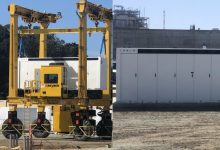US battery and electric vehicle darling Tesla and Californian utility Pacific Gas and Electric Company (PG&E) have begun installing the first Tesla Megapacks at their 730MWh battery energy storage system at the ageing Moss Landing gas power plant in central California.
The mammoth 182.5MW/730MWh battery energy storage system (BESS) is located at the site of PG&E’s Moss Landing electric substation, and will include 235 Tesla Megapack battery units, and is set to be operational by the second quarter of 2021.
Just over two months after ground was first broken on the project, PG&E announced this week on its Twitter account that the first Tesla Megapacks had been installed at the site.
The first @Tesla Megapacks installed at PG&E’s Moss Landing substation. Once operational (targeting 2Q 2021) this 182.5MW battery #energystorage system will be one of the largest utility-owned, lithium-ion battery energy storage systems in the world. ???? pic.twitter.com/EW2MEm5Iz8
— PG&E (@PGE4Me) October 6, 2020
Tesla’s Megapacks are the company’s large-scale battery storage solution, designed as “a sustainable alternative to natural gas “peaker” power plants.” Each Megapack unit boasts storage capacity 3MWh and can scale to over 1GWh.
The electric substation and under-construction battery system are located alongside the ageing Moss Landing Power Plant, a natural gas-fired power plant which was once the largest power plant in California with a generation capacity of 2,560MW.
However, already two of the Power Plant’s steam units have been taken offline, and having been commissioned all the way back in 1950, its age and the rise of renewable energy is making the Moss Landing Power Plant a difficult proposition to continue.
Upon completion, PG&E’s Moss Landing battery energy storage system will dwarf the world’s previous largest such battery project, Australia’s Hornsdale Power Reserve, which was brought online at 100MW/129MWh and upgraded last month to 150MW/194MWh.
The Hornsdale Power Reserve was originally completed in less than 100 days in late 2017 after a Twitter exchange between Tesla CEO Elon Musk and Australia software billionaire Mike Cannon-Brookes.
Hornsdale was recently surpassed after LS Power announced in August that it had boosted the size of its Gatway project in the East Otay Mesa community in San Diego County in California to a capacity of 230MW – up from an initial 62.5MW/62.5MWh.
However, PG&E’s Moss Landing BESS will too be dwarfed, by a much closer neighbour, with Vistra Corp’s mammoth 1,500MW/6,000MWh – consisting of a 300MW/1,200MWh Phase 1 and a 100MW/400MWh Phase 2.
Announced back in May and permission granted in August, the first 300MW/1,200MWh phase is expected to be completed by the end of 2020 and the second phase to be completed some time in 2021.










